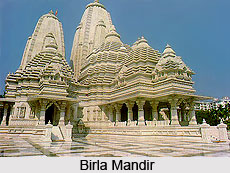 The Birla Mandir located in the north of Brahma Sarovar, is a stylish piece of structural design. It is purely made up of white marble, enhancing the loveliness of Kurukshetra. In the garden of the Temple, there is a big sized marble chariot. The chariot is seen drawn by four horses. Lord Krishna and Arjun are seen sitting on it. There is one couplet from each of the eighteen chapters of Geeta inscribed on all sides of the chariot. In addition to these, there is also a `Gaj Ghanta` made of white marble installed in the garden.
The Birla Mandir located in the north of Brahma Sarovar, is a stylish piece of structural design. It is purely made up of white marble, enhancing the loveliness of Kurukshetra. In the garden of the Temple, there is a big sized marble chariot. The chariot is seen drawn by four horses. Lord Krishna and Arjun are seen sitting on it. There is one couplet from each of the eighteen chapters of Geeta inscribed on all sides of the chariot. In addition to these, there is also a `Gaj Ghanta` made of white marble installed in the garden.
According to a popular legend, a Titu bird had laid her eggs in the fields where the Kurukshetra war was fought in the Mahabharata. She was worried about the safety of her newborn kids when she saw the movements of the elephants. She prayed to God and a bell broke from the neck of an elephant and fell over the nest. Thus, the nest was made secure throughout the eighteen-day war of Kurukshetra.
The main hall consists of the idol of Lord Krishna, portraits of Guru Nanak, Guru Gobind, Sant Ravi Dass, Guru Teg Bahadur, Ved Vyas, and Tulsi Das along with their sayings.
Other than this there is a `dharmasala` within the temple complex. The main festival celebrated in the temple is Janmashtami. It is celebrated with great pomp and enthusiasm.





















